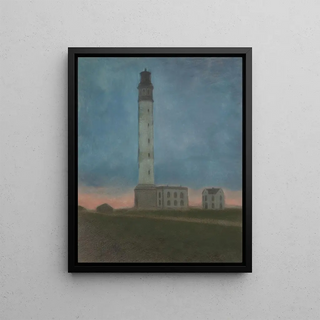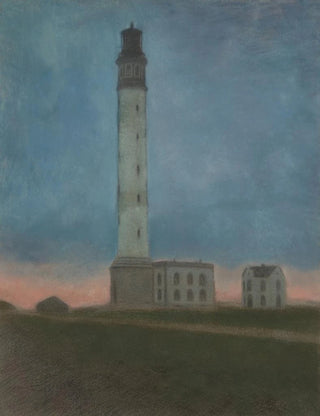Art print | The Ostend lighthouse at sunrise - Léon Spilliaert


View from behind

Frame (optional)
In the fascinating world of art, some works stand out for their ability to capture fleeting moments and transform them into palpable emotions. "Le phare d'Ostende au lever du soleil" by Léon Spilliaert is one of those creations that, through its delicate nuances and immersive atmosphere, transports us to the heart of a maritime landscape at dawn. This art print evokes not only the beauty of a sunrise over the North Sea but also the melancholy and solitude that often characterize the work of this Belgian artist. By contemplating this piece, the viewer is invited to feel the gentle morning light, to immerse themselves in the reflections on the water, and to ponder the mysteries hidden beyond the horizon.
Style and uniqueness of the artwork
Léon Spilliaert's work is distinguished by its unique style, which combines symbolism with an almost expressionist approach. In "Le phare d'Ostende au lever du soleil," the lighthouse, an iconic figure of navigation, stands proudly on the canvas, while the sky lights up with golden and orange hues, creating a striking contrast with the dark waters. The composition is both simple and powerful, with each element carefully arranged to evoke an atmosphere of mystery. The brushstrokes, both fluid and controlled, give the scene an almost dreamlike quality. Spilliaert manages to capture the very essence of the moment, transforming an ordinary scene into an extraordinary visual experience. The nuances of light and shadow play a vital role in this art print, highlighting the emotional depth emanating from every detail.
The artist and his influence
Léon Spilliaert, born in 1881 in Ostende, is an artist whose journey is marked by an unceasing quest for identity and light. Influenced by symbolism and post-impressionism, he develops a personal style that transcends the conventions of his time. His attachment to the sea and his hometown port imbues his work with a unique atmosphere, where nature becomes a reflection of his inner states. Spilliaert is

Matte finish

View from behind

Frame (optional)
In the fascinating world of art, some works stand out for their ability to capture fleeting moments and transform them into palpable emotions. "Le phare d'Ostende au lever du soleil" by Léon Spilliaert is one of those creations that, through its delicate nuances and immersive atmosphere, transports us to the heart of a maritime landscape at dawn. This art print evokes not only the beauty of a sunrise over the North Sea but also the melancholy and solitude that often characterize the work of this Belgian artist. By contemplating this piece, the viewer is invited to feel the gentle morning light, to immerse themselves in the reflections on the water, and to ponder the mysteries hidden beyond the horizon.
Style and uniqueness of the artwork
Léon Spilliaert's work is distinguished by its unique style, which combines symbolism with an almost expressionist approach. In "Le phare d'Ostende au lever du soleil," the lighthouse, an iconic figure of navigation, stands proudly on the canvas, while the sky lights up with golden and orange hues, creating a striking contrast with the dark waters. The composition is both simple and powerful, with each element carefully arranged to evoke an atmosphere of mystery. The brushstrokes, both fluid and controlled, give the scene an almost dreamlike quality. Spilliaert manages to capture the very essence of the moment, transforming an ordinary scene into an extraordinary visual experience. The nuances of light and shadow play a vital role in this art print, highlighting the emotional depth emanating from every detail.
The artist and his influence
Léon Spilliaert, born in 1881 in Ostende, is an artist whose journey is marked by an unceasing quest for identity and light. Influenced by symbolism and post-impressionism, he develops a personal style that transcends the conventions of his time. His attachment to the sea and his hometown port imbues his work with a unique atmosphere, where nature becomes a reflection of his inner states. Spilliaert is






